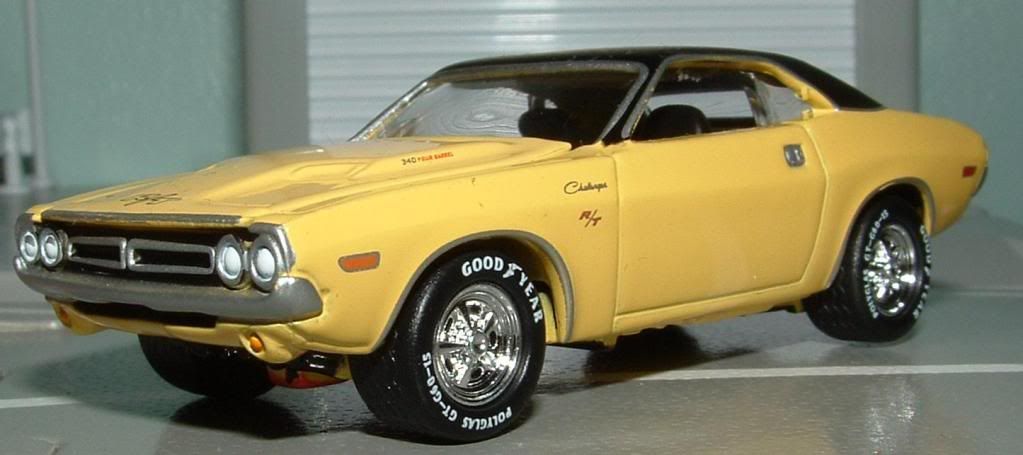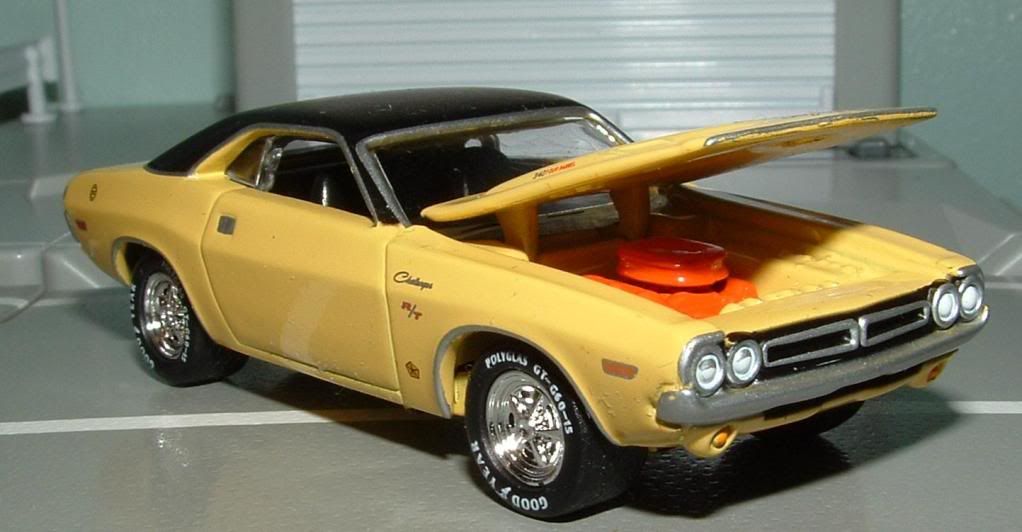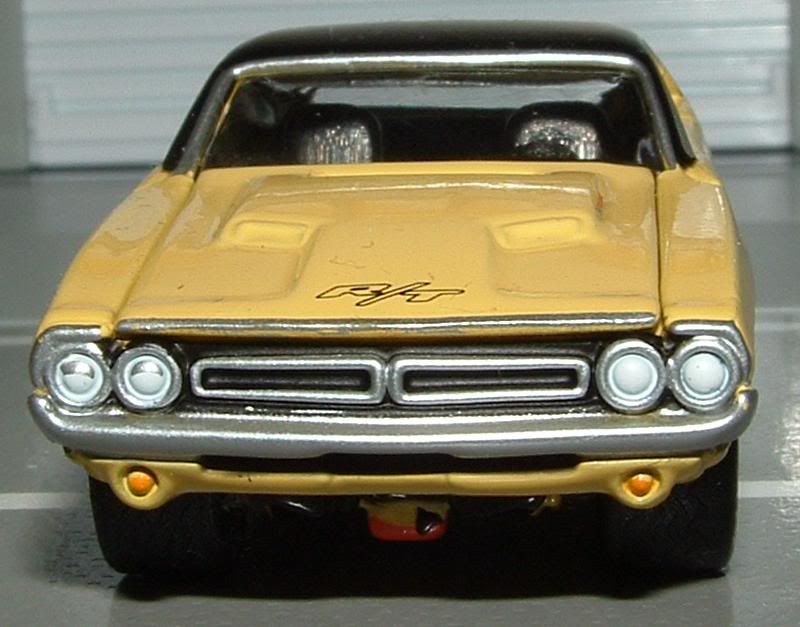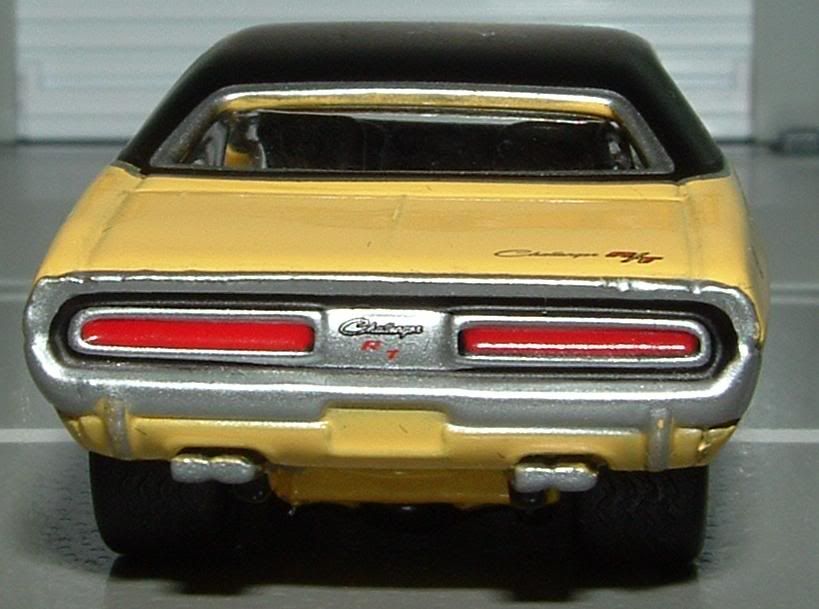Today's car of the day is Johnny Lightning's 1971 Dodge Challenger R/T.
The first car that carried the Challenger name was the limited edition 1959 Dodge Silver Challenger. This was a six-cylinder or V-8 model available only in silver paint and only on a two-door body. It came with many extra features at no cost, such as wall-to-wall deep pile carpeting, premium white wall tires and wheel covers, luxury fabrics and upgraded interior and electric windshield wipers.
The first generation Dodge Challenger was a pony car built from 1970 to 1974, using the Chrysler E platform and sharing major components with the Plymouth Barracuda. The second generation, from 1978 to 1983, was a badge engineered Mitsubishi Galant Lambda. The third, and current generation, was introduced in 2008 as a rival to the evolved fifth generation Ford Mustang and the reintroduced fifth generation Chevrolet Camaro.
For more information and pictures of the real car please visit: Dodge Challenger
This example of the JL Challenger was a Club exclusive and I believe was the debut of the tooling. Also notice this example has a textured rear panel- which is my biggest complaint about most releases of this casting. Up until I reviewed the photos for today's COTD I didn't realize any versions of this tooling had a detailed rear fascia. The smooth rear fascia just looks wrong and the tampos overtop of it look fake. With the needed texture, this one looks about perfect. And the hood fits too (another common problem of this tooling is hoods that don't shut properly)! The tampoed on gascap, however, is distracting.
The Challenger was described in a book about 1960s American cars as Dodge’s "answer to the Mustang and Camaro." It was one of two Chrysler E-body cars, the other being the slightly smaller Plymouth Barracuda. "Both the Challenger and Barracuda were available in a staggering number of trim and option levels" and were intended "to compete against cars like the Chevrolet Camaro and Ford Mustang, and to do it while offering virtually every engine in Chrysler's inventory." However, they were "a rather late response to the ponycar wave the Ford Mustang had started." In his book Hemi Muscle Cars, Robert Genat wrote that the Challenger was conceived in the late 1960s as Dodge’s equivalent of the Plymouth Barracuda, and that the Barracuda was designed to compete against the Mustang and Camaro. He added that Chrysler intended the new Dodge as "the most potent ponycar ever," and positioned it "to compete against the Mercury Cougar and Pontiac Firebird." Genat also noted that the "Barracuda was intended to compete in the marketplace with the Mustang and Camaro/Firebird, while the Dodge was to be positioned against the Cougar" and other more luxury-type musclecars.
The Challenger's longer wheelbase, larger dimensions and more luxurious interior were prompted by the launch of the 1967 Mercury Cougar, likewise a bigger, more luxurious and more expensive pony car aimed at affluent young American buyers. The wheelbase, at 110 inches (2,794 mm), was two inches longer than the Barracuda, and the Dodge differed substantially from the Plymouth in its outer sheetmetal, much as the Cougar differed from the shorter-wheelbase Ford Mustang.
Exterior design was done by Carl Cameron, who also did the exterior for the 1966 Dodge Charger. Cameron based the 1970 Challenger grille off an older sketch of his 1966 Charger prototype that was to have a turbine engine. The Charger never got the turbine, but the Challenger got that car's grille. Although the Challenger was well-received by the public (with 76,935 produced for the 1970 model year), it was criticized by the press, and the pony car segment was already declining by the time the Challenger arrived. Sales fell dramatically after 1970, and Challenger production ceased midway through the 1974 model year. About 165,500 Challengers were sold over this model's lifespan.
Four hardtop models were offered: Challenger Six, Challenger V8, T/A Challenger (1970 only), and Challenger R/T with a convertible version available only in 1970 and 1971. Although there were no factory-built R/T Challenger convertibles for 1971, the R/T continued as a model with the hardtop body-style. The standard engine on the base model was the 225 cu in (3.7 L) six-cylinder. The standard engine on the V8 was the 230 bhp (171.5 kW)318 cu in (5.2 L) V8 with a 2-barrel carburetor. Optional engines were the 340 cu in (5.6 L) and 383 cu in (6.3 L) V8s, all with a standard 3-speed manual transmission, except for the 290 bhp (216.3 kW) 383 CID engine, which was available only with the TorqueFlite automatic transmission. A 4-speed manual was optional on all engines except the 225 CID I6 and the 2-barrel 383 CID V8.
The performance model was the R/T (Road/Track), with a 383 CID Magnum V8, rated at 335 bhp (249.8 kW); 300 bhp (223.7 kW) for 1971, due to a drop in compression. The standard transmission was a 3-speed manual. Optional R/T engines were the 375 bhp (279.6 kW) 440 cu in (7.2 L) Magnum, the 390 bhp (290.8 kW) 440 CID Six-Pack and the 425 bhp (316.9 kW) 426 cu in (7.0 L) Hemi. The R/T was available in either the hardtop or convertible. Base hardtop models and R/T hardtops could be ordered with the more luxurious SE specification, which included leather seats, a vinyl roof, a smaller 'formal' rear window, and an overhead interior console that contained three warning lights (door ajar, low fuel, and seatbelts). The Challenger R/T came with a Rallye instrument cluster that included a 150 mph (240 km/h) speedometer, an 8,000 rpm tachometer, 1972-1974 tachometer went to 7,000 rpm and an oil pressure gauge. In 1973, the R/T badging was dropped and these models were called "Rallye", although they were never badged as such. The shaker hood scoop was not available after 1971.
A 1970-only model was the Dodge Challenger T/A (Trans Am) racing homologation car. In order to race in the Sports Car Club of America's Trans American Sedan Championship Trans Am, Dodge built a street version of its race car (just like Plymouth with its Plymouth 'Cuda AAR) which it called the Dodge Challenger T/A (Trans Am). Although the race cars ran a destroked version of the 340, street versions took the 340 and added a trio of two-barrel carburetors atop an Edelbrock aluminum intake manifold, creating the 340 Six Pack. Dodge rated the 340 Six Pack at 290 bhp (216.3 kW), only 15 bhp (11 kW) more than the original 340 engine (which also had the same rating as the Camaro Z/28 and Ford Boss 302 Mustang). The engine actually made about 320 bhp (238.6 kW). It breathed air through a suitcase sized air scoop molded into the pinned down, hinged matte-black fiberglass hood. Low-restriction dual exhausts ran to the stock muffler location, then reversed direction to exit in chrome tipped "megaphone" outlets in front of the rear wheels. Options included a TorqueFlite automatic or pistol-grip Hurst-shifted four-speed transmission, 3.55:1 or 3.90:1 gears, as well as manual or power steering. Front disc brakes were standard. The special Rallye suspension used heavy duty parts and increased the rate of the rear springs. The T/A was the first U.S. muscle car to fit different size tires front and rear to give a racing stance: E60x15 in the front, and G60x15 in the rear. The modified chamber elevated the tail enough to clear the rear rubber and its side exhaust outlets. Thick dual side stripes, bold ID graphics, a fiberglass ducktail rear spoiler, and a fiberglass front spoiler added to the racing image. The interior was strictly stock Challenger.
Dodge contracted Ray Caldwell's Autodynamics firm in Marblehead, Massachusetts to run the factory Trans-Am team. Sam Posey drove the #77 "sub-lime" painted car that Caldwell's team built from a car taken off a local dealer's showroom floor. When the #76 was completed mid-season from a chassis provided by Dan Gurney's All American Racers, Posey alternated between the two. Both cars ran the final two races, with Posey in the #77. Ronnie Bucknum drove the #76 at Seattle Washington, and Tony Adamowicz drove it at Riverside, California.
The Challenger T/A's scored a few top three finishes, but lack of a development budget and the short-lived Keith Black 303 c. i. engines led to Dodge leaving the series at season's end. .
The street version suffered from severe understeer in fast corners, largely due to the smaller front tires. Only 2,399 T/As were made. A 1971 model using the 340 engine with a 4-barrel carburetor was planned and appeared in advertising, but was not produced since Dodge had left the race series.
The "Western Special" was a version available only to west coast dealers. It came with a rear-exit exhaust system and Western Special identification on the rear decklid. Some examples came with a vacuum-operated trunk release. Another late production version was the low-priced "Deputy", stripped of some of the base car's trim and with fixed rear side glass.
By 1972, the convertible version and all the big-block engine options were gone. Maximum power was also downgraded to 240 horsepower (180 kW) to reflect the more accurate Society of Automotive Engineers (SAE) net hp calculations. The 1972 models also received a new grille that extended beneath the front bumper. The only 1972 convertibles which exist are actually 1971 models with the 1972 front end (grille, lights, etc.) and rear end (tail lights and their panel). These were specially built for TV programs such as "Mod Squad". The only way to ascertain a 'real' 1972 Challenger convertible is to look at its fender tag. On the code line which gives the dealer order number, that number will start with an "R", which designates "Special Meaning" (in this case, a TV 'special promotions' car).
The 1973 models were no longer available with a six-cylinder engine. For 1974, the 340 cu in (5.6 L) engine was replaced by a 360 cu in (5.9 L) version, but the pony car market had deteriorated and production of Challengers ceased in mid-1974.








No comments:
Post a Comment